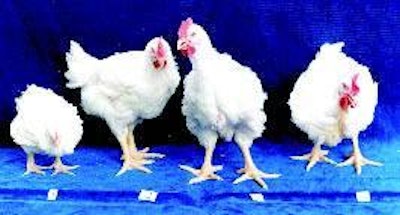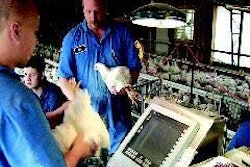
The high level of performance achieved by today's chickens has made them more prone to metabolic diseases like ascites, sudden death syndrome and skeletal abnormalities. The rapid growth rate in broilers is associated with tibial dyschondroplasia (TD). Reducing the growth of broilers can reduce the incidence of TD but this is not an economic solution.
Furthermore, the intensification of poultry operation also has environmental impacts, and it may lead to environmental pollution if manure contaminates ground and surface water. The primary reason for this type of pollution is leaching of phosphorus (P), which is not utilised by the bird (phytate). Balanced nutrition, particularly calcium (Ca) and P, can help combat this problem and yet still allow the birds to achieve their genetic potential. Imbalances of these minerals will result in economic losses through reduced growth, poor carcass quality, reduced egg production, broken eggshells and lameness.
One form of vitamin D cholecalciferol (CC) enhances the utilisation P and Ca bound to phytate, as well as other minerals, including manganese, iron, copper and zinc.
It is also involved in the development of cell-mediated immunity in chicken through its role in the maturation and proper functioning of the macrophages.
Interactions of CC with other factors
The requirement of CC in the chicken largely depends on the levels and the ratio of Ca and P and concentration of phytate P in diet, as well as the concentrations of vitamins C and A; supplemental fat, nature of the light, etc are also known to modify the CC requirements in chicken. The requirement for CC is also elevated in diets contaminated with mycotoxins.
Ca:P ratio
A wide Ca:P ratio leads to the formation of calcium phosphate, which is insoluble in the gut and is excreted. This can lead to deficiencies of Ca and P in the bird, as well as contributing to environmental pollution when the manure is used as a fertiliser for crop production. Increasing this ratio has also been reported to reduce the activity of mucosal phytase up to 15%. These effects can be overcome by dietary supplementation of CC.
Phytate
Several reports indicate that supplementation with either CC or its metabolites to diets with a low ratio of Ca to inorganic P (iP) improves the utilisation of phytate P. CC is known to increase the activity of intestinal phytase in chicken. However, the efficiency of CC in improving the utilisation of phytin P is influenced by the dietary concentrations of Ca and P. An increase in Ca:iP ratio suppresses P availability through the formation of an insoluble complex and by inhibiting intestinal phytase activity. At sub-optimal levels of Ca and iP in diet, CC elicits maximum influence on phytin utilisation. At lower concentrations of Ca:aP (0.4%:0.2%, respectively), bodyweight gain increased progressively with the level of CC in diet (300 to 1200ICU/kg). Since the absorption of Ca is enhanced by CC supplementation, less Ca is present in the gut to interfere with the utilisation of P and phytate from dietary source. No improvement in growth was observed with the vitamin supplementation at higher levels of these minerals above 0.6% Ca and 0.3% iP. The improvement in growth of broilers fed diets containing sub-optimal Ca:iP levels appears to be through increased phytate P availability. The data suggested lower requirement for CC (300 ICU/kg) when the diet contains a better balance of Ca and iP.
Vitamin C & A
Vitamin C plays a role in the conversion of CC to 1,25-DHCC, the metabolically active form. Hence, higher concentrations of vitamin C (250 to 3000mg/kg diet) increase bone mineralisation and reduce the incidence of rickets in birds. During thermal stress, the synthesis of vitamin C and the conversion of CC to 1,25-DHCC are reduced. A higher concentration of CC is recommended during the summer months.
An excessive dietary vitamin A level (45,000IU/kg or above) interferes with the utilisation of CC and its metabolites in chickens.
Fat
Dietary fat levels above 9% decrease Ca retention and bone calcification. This is thought to be due to the formation of Ca and Mg soaps, which are not absorbed through the gut and lead to deficiencies of these minerals. The supplementation of CC to a diet containing 7.9% fat increased the tibia ash content.
Light
The source of light provided in the poultry house influences the bird's requirement for CC. The requirement is lower in chicks exposed to ultraviolet (UV) rays from fluorescent bulbs than those under incandescent bulbs, which do not produce significant UV light. A higher incidence of TD was reported in broilers fed adequate levels of Ca and CC (400 ICU/kg diet) in the absence of fluorescent light. In the absence of UV rays, the requirement of CC for optimum growth and leg health is much higher (800 to 1500 ICU/kg), even with diets containing the recommended levels of Ca and iP (1.1 and 0.61%, respectively).
Mycotoxins
Aflatoxin in the diet reduces the utilisation of CC, while fusarium toxin changes its basic steroid structure, reducing availability. The negative effects of aflatoxin (2500ppb) on growth and haematocrit were partially alleviated by higher levels of CC (4400 ICU/kg) in the diet.
Age and breed
The enzyme required to convert CC to its active form is not fully active in chickens under 14 days of age, and the chick depends on the maternal supply of the vitamin through the yolk. Chicks from parents fed deficient levels of CC exhibit lameness, irrespective of the CC concentration in the chick's diet. Furthermore, the activity of the critical enzyme in the kidney declines with age, and so supplementation of CC metabolites or higher levels of CC in aged layer diet improve eggshell quality. A high incidence of TD in certain breeds has been attributed to poor utilisation of CC.
Metabolites of CC
CC is converted to 25-HCC initially and, depending on the status of Ca and P in the serum, this may be further hydroxylated to 1,25-DHCC. The former is the predominant metabolite in the circulation, while the latter is the active form of the vitamin, which takes part in the metabolism of Ca and P. The absorption of 25-HCC is considerably higher (83.6%) than that of CC (66.5%) in chicks, and it is around ten times more effective than CC in the prevention of skeletal disorders.
The CC metabolites with a hydroxyl group at position one, i.e. 1-H-CC, 1,25-DHCC and 1,24R-DHCC, have been reported to prevent TD and to increase bone ash content. Similarly, replacing CC with 25-HCC on a weight basis (3000 ICU/kg) significantly decreased the incidence of TD from 65 to 10% in broiler chickens fed diets with the recommended levels of Ca and P. The metabolites of CC (25-HCC, 1,25-DHCC) enhance the activity of intestinal phytase in chicken and increase the availabilities of P and Ca from plant feed ingredients. However, proper mixing is essential when the metabolites are used in poultry diets, as these compounds are more toxic than CC.
Requirements
The requirement for CC in chickens depends on a number of factors already discussed. It is lower in diets containing adequate levels of Ca, and increases (800 to 7920 ICU/kg) as the levels of Ca and iP in the diet are increased. At adequate levels of Ca (1%) and iP (0.49%), 200ICU/kg diet was adequate for maximum growth.
The requirement for maximum bone ash content is higher than for maximum bodyweight gain. Studies conducted at this laboratory suggested the possibility of reducing the dietary levels of Ca and iP to 50% of their respective recommendations by increasing the concentration of supplemental CC from 200 to 3600 ICU/kg diet without affecting weight gain, feed efficiency, leg score and bone mineralisation (Table 1). This approach can bring considerable feed cost savings (US$3.50/tonne), as well as reducing P excretion.
CC & tibial dyschondroplasia
The development of TD is characteristic of CC deficiency in broiler chickens, particularly in faster growing birds. Each increase of 400ICU/kg in 25-OH-CC in the feed (up to 2800ICU/kg) has been predicted to reduce the incidence of TD by about 1-2% in broilers. Dietary supplementation with 1,25-DHCC has shown consistent positive results in alleviating TD by stimulating chondrocyte differentiation.
Toxicity
The toxic effects of CC in broilers depend on the level of Ca in the diet. As the level of Ca increases, the lower the levels of CC required to produce the negative effects, and so there is little risk of CC toxicity in practical diets. A CC level of 50,000ICU/kg did not result in any toxic effects on broiler chicks fed diets containing adequate Ca and P. A level of 138,000 ICU/kg diet led to renal calcification. Metabolites of CC are more toxic than the parent compound: 25-HCC is 5-10 times more toxic than CC, while 200ICU/kg 1,25-DHCC depressed the growth even in a diet with adequate Ca.
Summary
Cholecalciferol (CC) is an essential, fat-soluble vitamin and it plays an important role in the metabolism of Ca and P. The property of CC to enhance Ca absorption reduces the Ca concentration in the gut, which in turn enhances the utilisation of phytin P through increasing mucosal phytase. The need for supplemental P can be decreased considerably by CC supplementation, and this minimises the excretion of P to the environment.
Metabolites of CC are more effective than the parent compound in minimising rickets and tibial dyschondroplasia in broilers.
In practical broiler diets, CC at a level of 3600 ICU/kg allows optimum growth and bone mineralisation.

















